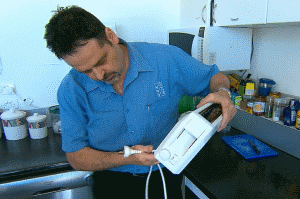
Testing and Tagging revisited – Safety Solutions Magazine
Originally Published – December 2006, Wendy Cramer, Safety Solutions Editor
Testing and tagging is one element of electrical safety that has caused confusion since its inception. In fact, in NSW, the regulations have been taken so much to heart by some businesses that an amendment was recently issued to clarify which appliances and environments need to be part of an ongoing testing and tagging routine.
The standard that applies in this area – AS/NZS 3760:2022 In-Service Safety Inspection and Testing of Electrical Equipment – specifies the safety inspection and maintenance standards for Australia and provides details of how to comply with OHS legislation in this area.
According to business development manager at Appliance Tagging Services, Sarah Allen the standard defines an appliance as any electrical item that can be plugged into a power point. It recommends that appliances be inspected at regular intervals ranging from six months to five years.
Why test?
“More than 1200 fires every year in Australia are attributed to electrical fault and dozens of people have serious electrical accidents due to poor maintenance of appliances,” Allen says.
“In fact, we find up to 10% of all electrical items that are tested for the first time fail the testing procedure.”
It has become a huge issue in the workforce, as each employer has a duty of care to provide a safe place of work for employees, and the potential for injury or fatality due to electrical faults is very real.
Some of Australia’s states have more specific requirements than others when it comes to testing and tagging, although all state regulators have the minimum ‘duty of care’ requirement for employers and business owners.
But there is still no excuse for businesses operating in states with less prescriptive electrical safety requirements. Should an injury or fatality occur due to an electrical fault, a court of law could still bring up the relevant standard as a minimum benchmark of safety, even though the standard is not written in legislation.
Actual testing practices were not the focus of the recent amendment in NSW as to testing and tagging regulations, but rather the extent to which appliances should be tested.
Basic requirements
To comply with basic requirements, Appliance Tagging Services recommends implementing the following:
- A test tag to each item indicating date, item, person performing and status (pass/fail) of test.
- An asset register and historical record of all test items and test results.
- A record of results including faulty item and repair action.
Marketing manager at Emona Instruments, Mark Breznik told Safety Solutions that when testing and tagging requirements were first issued in NSW, they were only compulsory for construction sites. This meant that companies such as BHP, which also implemented testing and tagging systems, were doing it as part of their own best practice safety initiatives.
When more general regulations were issued, they were in fact meant for hazardous environments such as within manufacturing facilities. But the ensuing climate of regulatory fear saw many businesses testing and tagging anything and everything for fear of non-compliance.
“The original regulations were not really meant for all office environments as they are generally not high risk,” says Breznik.
Therefore, the position paper released this year to amend the regulations in NSW has a focus on risk assessment.
Breznik explains that if a proper risk assessment has been done and concludes that some appliances are not in “hazardous environments”, then they do not require testing and tagging.
These risk assessments need to be done every year, as opposed to the testing and tagging of some appliances that only needs to be done every five years, according to the standard.
Considering that risk assessments need to be done by someone qualified, and not just the office manager, “some businesses actually find it easier to get someone in to do the test every year than worry about ongoing risk assessments”, Breznik says.
Risk assessments take into account the environment that the appliances are operating under. If it is a hostile environment, testing and tagging will be necessary. If not, they will be subject to another risk assessment in 12 months.
Breznik describes a hostile environment as one that is subject to moisture, dust, heat and corrosive materials or where the cord is subject to regular flexing – for example, where an appliance is regularly moved from one location to another.
The frequency of testing is set out in most states’ electrical safety regulations, as well as the standards. In hostile environments, some states require monthly testing and some stipulate three-monthly. It’s worth contacting the relevant WorkSafe/WorkCover body in your state for the current requirements.
Get a free quote
"*" indicates required fields